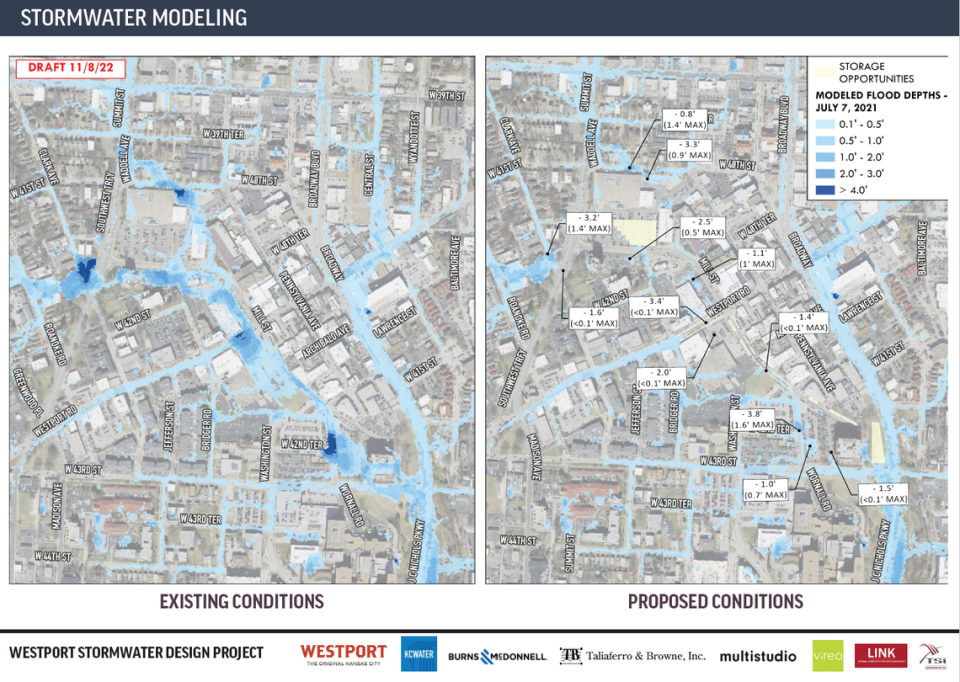Business group unveils new proposal to alleviate flooding in Kansas City’s Westport
A Westport business group on Tuesday publicly unveiled a proposed storm water project meant to curb seasonal Kansas City flooding that has for decades proved disastrous for many who visit or live in the popular bar and entertainment district.
The proposed project, which has a target price tag of about $15 million, would involve the construction of permeable pavement parking spaces that can soak up flood water along Mill Street.
Tree planters — or Green Infrastructure, in project terms — would be installed along sidewalks where storm water would naturally drain and be stored, also feeding plant life. And underground pipes would lead to even larger underground storage beds underneath Dr. Jeremiah Cameron Park and Sun Fresh Market parking lot at 40th Street and Southwest Trafficway.
The concept was developed for the Westport Regional Business League, an organization representing area business owners, by engineering firms hired to evaluate Westport for its specific flooding needs.
“It’s been a long time coming,” said Kim Kimbrough, executive director of the group, which has been lobbying the city to help build a better stormwater system in Westport for years.
The latest proposal is about a year in the making. As of Tuesday, the Westport group was seeking input from community members as they hope to put final touches on the concept with the aim of having a final draft ready to present to City Hall officials by the end of January.
The current effort is spearheaded by the Westport business group in collaboration from KC Water.

Partnership on flood control in Westport
Wes Minder, the city’s director of water services, told The Star that the hope with the public-private partnership was to ensure people in Westport had a seat at the table as a proposal was drafted to address a longstanding issue for the district. Minder also said he is hopeful that there will be room in the city’s capital budget for a stormwater project that can help Westport.
Built atop a stretch of land that was once a creek, Mill Street is an anchor point for the proposed development to alleviate flooding across Old Westport, an area known to collect several feet of water during severe storms, often in springtime, during heavy rains and overloads of the city’s sewer pipes.
In May 2020, flash flooding across the Kansas City area Thursday left portions of Westport inundated and trapped drivers who ventured into high water. Streets previously were inundated in February 2018 and, in August of 2016 when nearly 100 cars were damaged and some people had to be rescued.
Current situation at Westport and Mill pic.twitter.com/V84Y0yFRfp
— kcpolice (@kcpolice) May 28, 2020
Engineering design firms modeling for the potential impacts of the full project anticipate a major decrease in standing water during flood events if the project gets done. For example, the area near Mill Street and Westport Road is expected to have a maximum flood depth of about an inch — rather than a few feet.
Green infrastructure
Andy Sauer, an engineer specializing in green infrastructure and stormwater management, said the concept of the design begins with viewing rainfall and flood waters as a resource instead of waste. He pointed to green-friendly initiatives becoming more popular around the country, including so-called green roofs in New York, as a similar approach to handling stormwater.
“If you take (stormwater) runoff and take it to a tree, take it to a garden, it becomes a way to sustain plants — not a waste, right? So when you start to flip that conversation, the solutions look a little different. They’re more challenging to implement. But Kansas City and other cities are seeing the benefit of those. And this project, I think, really highlights those things.”
“We’re not eliminating flooding. We are reducing flooding to the point that you can live with the water,” Sauer added, saying: “You don’t want to have four feet of water in your business. But if it’s seven inches outside of your business, (you) could probably live with that. And I can reduce the cost a lot for the city.”
A glimpse of what a new, tree-lined Mill Street would look like was on display Tuesday evening in the Multistudio space at 4200 Pennsylvania Ave.
Visitors to the open-house-style presentation were greeted with video footage from a flooding event that unfolded last year where personal vehicles were submerged and destroyed. Storyboards were set up across the venue demonstrating through illustrations and descriptions the plan to alleviate flooding there.
Among those seeing the proposal for the first time was Robert Carlston, a Westport resident since April 2021. He said he wanted to learn more about what’s being done to address flooding in his neighborhood.
“My first year I had problems, Carlston said, adding: “If I had one of those large 100-year flood type things then I would really have problems.”

 Yahoo Movies
Yahoo Movies 
